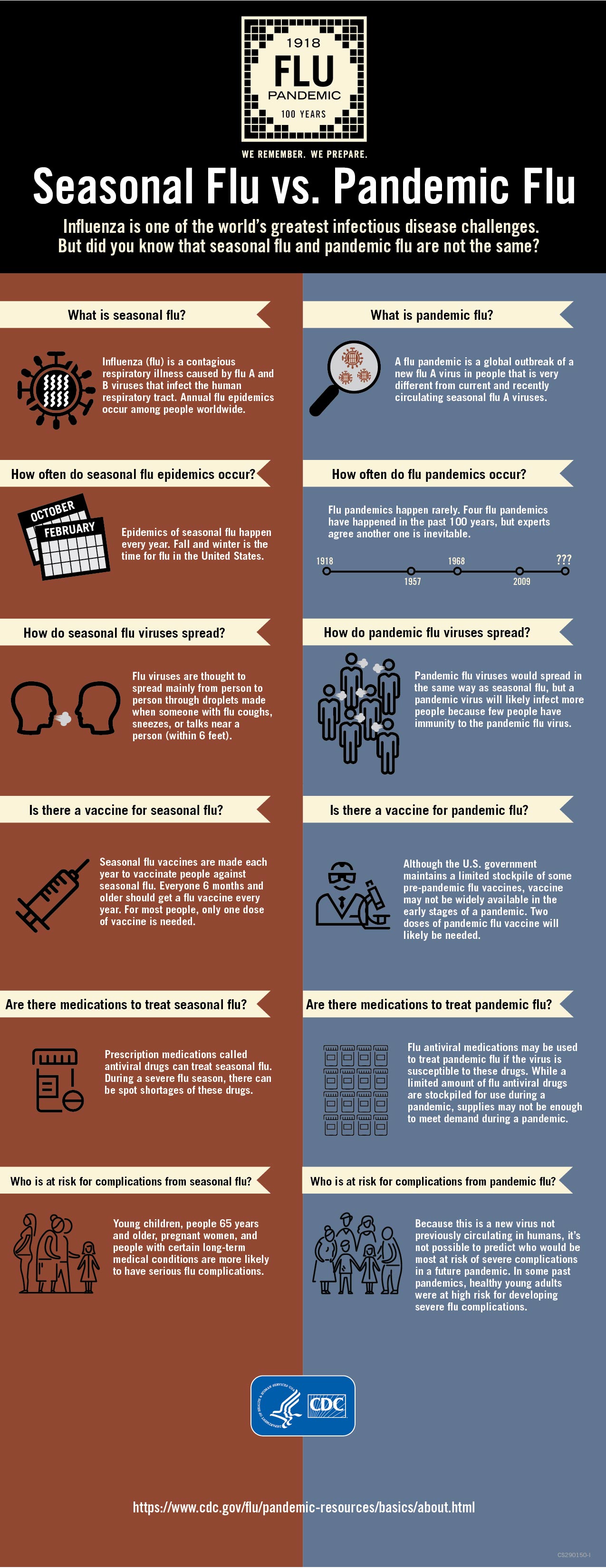Purpose
- An influenza pandemic is a global outbreak of a new influenza A virus that is very different from current and recently circulating human seasonal influenza A viruses.
- Pandemics happen when new (novel) influenza A viruses emerge which are able to infect people easily and spread from person to person in an efficient and sustained way.
Pandemic Basics
Because the virus is new to humans, very few people will have immunity against the pandemic virus, and a vaccine might not be widely available. The new virus will make a lot of people sick. How sick people get will depend on the characteristics of the virus, whether or not people have any immunity to that virus, and the health and age of the person being infected. With seasonal flu, for example, certain chronic health conditions are known to make those people more susceptible to serious flu infections. The risk factors associated with seasonal flu can be found at "People at High Risk of Developing Flu–Related Complications." Influenza pandemics are uncommon; only occurred during the 20th century.
Seasonal Flu
Pandemic Flu
How often does it happen?
Happens annually and usually peaks between December and February
Rarely happens (three times in 20th century)
Will most people be immune?
Usually some immunity from previous exposures and influenza vaccination
Most people have little or no immunity because they have no previous exposure to the virus or similar viruses
Who is at risk for complications?
Certain people are at high-risk for serious complications (infants, elderly, pregnant women, extreme obesity and persons with certain chronic medical conditions)
Healthy people also may be at high risk for serious complications
Where can I get medical care?
Health care providers and hospitals can usually meet public and patient needs
Health care providers and hospitals may be overwhelmed
Alternate care sites may be available to meet public and patient needs
Will a vaccine be available?
Vaccine available for annual flu season
Usually, one dose of vaccine is needed for most people
Although the US government maintains a limited stockpile of pandemic vaccine, vaccine may not be available in the early stages of a pandemic
Two doses of vaccine may be needed
Will antivirals be available?
Adequate supplies of antivirals are usually available
Antiviral supply may not be adequate to meet demand
How many people could get sick and suffer complications?
Rates of medical visits, complications, hospitalizations and death can vary from low to high
CDC estimates that flu-related hospitalizations since 2010 ranged from 140,000 to 710,000, while flu-related deaths are estimated to have ranged from 12,000 to 56,000.
Rates of medical visits, complications, hospitalizations and death can range from moderate to high
Number of deaths could be much higher than seasonal flu (e.g. The estimated U.S. death toll during the 1918 pandemic was approximately 675,000)
What impact will it have on schools and workplaces?
Usually causes minor impact on the general public, some schools may close and sick people are encouraged to stay home
Manageable impact on domestic and world economies
May cause major impact on the general public, such as travel restrictions and school or business closings
Potential for severe impact on domestic and world economies

